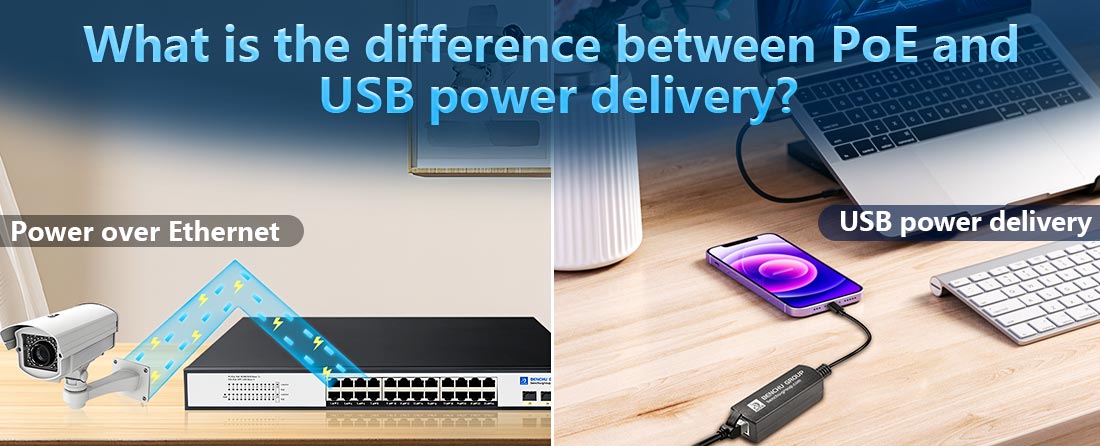
PoE (Power over Ethernet) and USB Power Delivery (USB-PD) are both technologies designed to transmit power along with data, but they are used in different contexts and have significant differences in functionality, application, and power capabilities. Here's a detailed comparison:
1. Technology and Standards
PoE (Power over Ethernet):
PoE delivers power over Ethernet (network) cables and is defined by the IEEE standards such as:
--- IEEE 802.3af (PoE): Provides up to 15.4W of power.
--- IEEE 802.3at (PoE+): Provides up to 30W of power.
--- IEEE 802.3bt (PoE++): Provides up to 60W (Type 3) and 100W (Type 4) of power.
PoE is primarily used for network devices like IP cameras, wireless access points, VoIP phones, and IoT devices, transmitting both data and power through Ethernet cables (Cat5e, Cat6, etc.).
USB Power Delivery (USB-PD):
--- USB Power Delivery is a standard for delivering higher levels of power over USB cables, particularly via USB Type-C connectors.
--- USB-PD can deliver up to 100W of power (via 5A at 20V), which is more than previous USB standards.
--- USB-PD is typically used for charging and powering devices like smartphones, tablets, laptops, and peripherals. It also supports fast charging for devices.
2. Power Capabilities
PoE:
The maximum power delivered depends on the PoE standard:
--- IEEE 802.3af: Up to 15.4W per port.
--- IEEE 802.3at (PoE+): Up to 30W per port.
--- IEEE 802.3bt (PoE++): Up to 60W (Type 3) or 100W (Type 4).
PoE can power multiple devices simultaneously via a switch, but the power is limited compared to USB-PD for a single device.
USB Power Delivery (USB-PD):
--- USB-PD can deliver up to 100W per port, which is significantly higher than basic PoE (802.3af) but comparable to PoE++ (IEEE 802.3bt Type 4).
--- USB-PD is often used for high-power applications such as charging laptops and running peripherals that require substantial power.
3. Use Cases
PoE:
--- Typically used in enterprise networks and industrial environments where both data and power need to be transmitted over long distances (up to 100 meters via Ethernet cables).
Commonly powers network devices like:
--- IP cameras for surveillance systems.
--- Wireless access points (WAPs).
--- VoIP phones and IoT sensors.
PoE is ideal for powering devices that need to be installed in locations without easy access to electrical outlets (e.g., ceilings, outdoor areas).
USB Power Delivery (USB-PD):
--- Predominantly used for consumer electronics to provide high-speed charging and data transmission over USB-C cables.
Powers and charges devices like:
--- Laptops, smartphones, tablets, power banks, and monitors.
--- USB-PD is commonly used for fast charging, where higher power is needed to charge devices quickly.
4. Data Transmission
PoE:
--- Transmits both power and data over a single Ethernet cable.
--- Supports high-speed Ethernet data transmission (Gigabit or 10Gbps) over long distances, making it ideal for networking environments.
USB Power Delivery:
--- Transmits power and data over USB cables, with USB-C supporting high-speed data transfer up to 40 Gbps using USB 4.0 or 10 Gbps using USB 3.1.
--- Primarily used for peripheral device communication (e.g., transferring data between laptops and smartphones) alongside power delivery.
5. Cable and Connector Types
PoE:
--- Uses Ethernet cables (Cat5e, Cat6) with RJ45 connectors to provide both power and data.
--- Typically designed for networking devices, with standardized cabling and connectors in enterprise environments.
USB Power Delivery:
--- Uses USB cables, primarily USB-C connectors for higher power and data delivery.
--- USB-PD is more prevalent in consumer electronics like laptops and smartphones, where USB-C is becoming the standard for charging and data transfer.
6. Distance
PoE:
--- Can transmit power and data over Ethernet cables up to 100 meters (328 feet) without signal loss. This makes it ideal for installations in large buildings or outdoor areas.
USB Power Delivery:
--- USB cables have shorter range limits, typically 2-4 meters for power delivery, though some specialized USB-C cables can go further. This limits USB-PD to more localized applications compared to PoE.
7. Installation and Infrastructure
PoE:
--- Typically used in structured cabling environments with switches, injectors, and routers that support PoE.
--- Often deployed in offices, industrial settings, and smart buildings where devices need both data and power in remote locations.
USB Power Delivery:
--- Designed for plug-and-play use in personal electronics and peripheral devices.
--- Requires only a USB-C port and compatible cable, making it ideal for charging and connecting devices in home and office environments.
Summary
| Feature | PoE (Power over Ethernet) | USB Power Delivery (USB-PD) |
| Power Output | Up to 100W (PoE++ Type 4) | Up to 100W (USB-C) |
| Cables | Ethernet cables (RJ45 connectors) | USB cables (USB-C connectors) |
| Distance | Up to 100 meters (328 feet) | Shorter, typically 2-4 meters |
| Primary Use Case | Network devices (IP cameras, WAPs, VoIP phones, etc.) | Consumer electronics (laptops, phones, tablets) |
| Data Transfer | Gigabit or higher over Ethernet | USB data speeds up to 40 Gbps (USB 4.0) |
| Application | Enterprise, industrial, smart buildings | Consumer electronics, charging, and data transfer |
In conclusion, PoE is more suited for enterprise-level networking and powering remote devices, while USB Power Delivery is designed for fast charging and high-speed data transfer in consumer electronics.